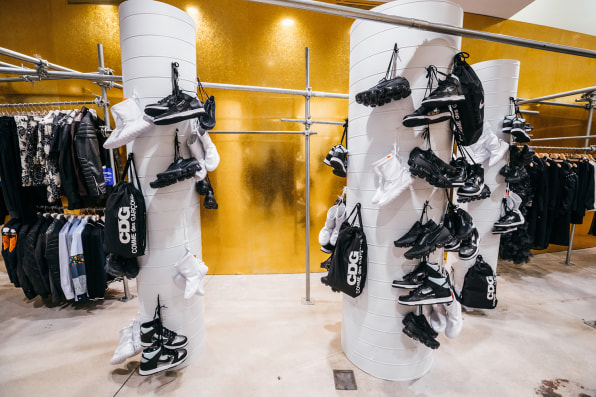Parts Breakdown Nike Shoe Fashion Product Description
In the mid-'80s, Nike released the Air Force Ane. It was the first sneaker to contain its pressurized air engineering that absorbs shock to aid athletes perform better. But, to everybody's surprise, the shoe became an instant fashion awareness on the streets of New York. They were so pop in Harlem and the Bronx that they caused the nickname "the uptowns." "It'due south just 1 instance of how sport and design collided," says Adrian Fenech, Nike's senior brand managing director for North America. "Information technology created a bond between Nike and the New York Metropolis community."
At New York Fashion Week, Nike is paying homage to its roots in New York City with events throughout the week as part of its "New York Made" series. On Thursday, Nike revealed its collaboration with Comme des Garçon, which resulted in a re-conceptualized Dunk How-do-you-do shoe with a articulate panel that allows wearers to express themselves through the socks they article of clothing underneath. On Saturday, at Bergdorf Goodman, Nike had a political party to celebrate Riccardo Tisci's new design: a Dunk made of high-end full-grain leather.
At the cult sneaker store Kith, Nike displayed a collection inspired by its 50 years of creating shoes for basketball game players, featuring one iconic blueprint to represent each decade. "We're listening to athletes about means that shoes bear upon performance, merely also hearing near their passion for luxury materials," says Fenech. "We've merged the 2, responding to their 24-hour interval-to-day needs, as well as their way inspiration.

To cap things off, Nike unveiled a new version of the Air Force One designed by Acronym'due south Errolson Hugh, which retains elements of the iconic shoe, but incorporates futuristic elements like a quick-release fastener to brand it easier to get into the shoe. "Errolson is all well-nigh form and functionality," Fenech explains. "The original shoe had heel tabs that allowed ease of access. Just Errolson took that idea and moved it forward."
This concept of "moving forrard" is a big theme at Nike. Fenech says that the company is trying to button the boundaries in terms of innovation, past creating high tech products that improve able-bodied performance, just it's also working to push ahead as a fashion brand. Mark Parker, Nike'southward CEO, began his career at Nike in the late '70s as a designer and believes that pattern thinking should infuse everything the company does. (To keep his ain artistic instincts sharp, he however occasionally collaborates with designers Tinker Hatfield and Hiroshi Fujiwara on express-edition sneakers as part of the Nike HTM Projection.)
Video: But Watch It: The History Of Nike In 3 Minutes
"Lab" Experiments
Nike is constantly working on deepening its fashion credentials. One identify this happens is the Nike Lab, which Fenech oversees. This is where many of the experimental collaborations begin. When picking partners, he explains that it usually begins when he discovers fashion designers who already have a passion for the brand. Only then, Fenech determines whether the relationship has the potential to push button Nike into new territory. "We look for partners that can stretch us," he says. "We similar relationships where information technology is mutually beneficial to learn from each other." These insights so trickle through the company, influencing the more than 650 designers who work at Nike.
But Nike also stays focused on the needs of its most loyal customers, who take e'er found means to incorporate sneakers into cutting-edge streetwear looks, much like the New Yorkers who took to the Air Force I iii decades ago. Then there's the sneakerhead customs that is passionate near each new cosmos that Nike brings to the market. Fenech says that these consumers tend to exist fatigued to narratives about how shoes fit into civilization and history. "Ultimately they're galvanized by stories," he says. "When we spend time with consumers in this globe, it's all almost collections of stories that connect our products with their twenty-four hours-to-day lives." The collection of shoes inspired by five decades of basketball was a manner of speaking directly to this community and showing how basketball culture has helped inform manner trends on the streets.
Nike also tries to be every bit specific as possible when speaking to communities. With 63,000 employees around the world, information technology's able to focus blueprint on the cultural nuances of a urban center, state, and fifty-fifty item historical events. Fenech says that New York Way Week gave Nike'southward designers an opportunity to think creatively near responding to the needs of fashion-forwards New Yorkers, but at every large cultural or sporting result, such as the Olympics, there's an effort to create products that are relevant. At the 2012 Olympics, for instance, Nike developed Flyknit engineering, made of ultra-light yarn, which was designed to improve athlete'due south performance and manufactured in a highly sustainable way that prevented waste; Nike was deliberately sending an environmentalist message at a moment of maximum global affect. The shoe apace became a fashion symbol in its own correct. "It was picked up as a trend and now allows us to push through new expressions of way," Fenech says.
In the stop, though, while fashion and style are of import, Fenech says that performance innovation must ever come first for Nike to stay at the cut edge. And then information technology's a constant balancing act betwixt investing in the slow, deliberate process of developing technology and keeping up with the latest styles. "We're very aware of trends, but in order to push forrad on our innovation agenda, we work on long lead times," he says. "This means trying to tune into moment-by-moment trends equally we go along with the help of athletes and collaborations with external partners. Information technology allows us to endeavor new things along the way."
0 Response to "Parts Breakdown Nike Shoe Fashion Product Description"
Post a Comment